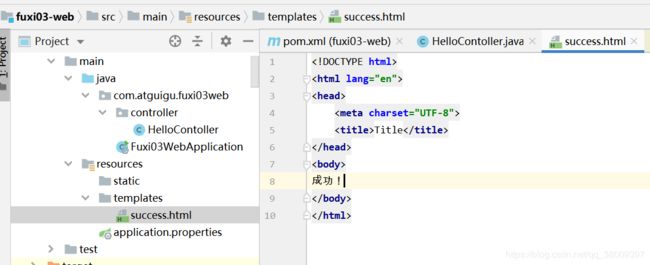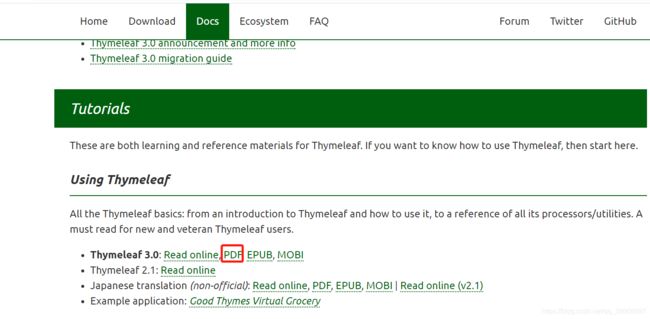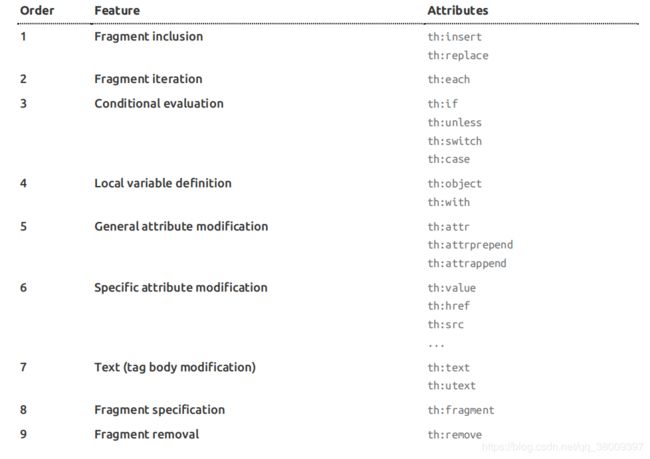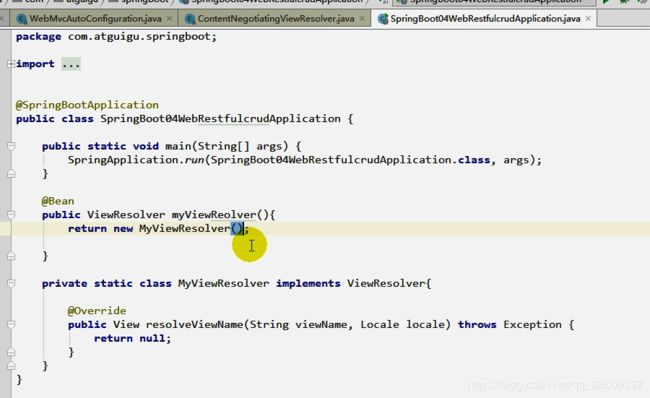springboot学习之旅03-web开发01
一.SpringBoot对静态资源的映射规则
1.1.源代码解析
关于这点我们可以查看WebMvcAuotConfiguration这个自动配置类的addResourceHandlers方法;
public static class WebMvcAutoConfigurationAdapter implements WebMvcConfigurer {
private static final Log logger = LogFactory.getLog(WebMvcConfigurer.class);
private final ResourceProperties resourceProperties;
private final WebMvcProperties mvcProperties;
private final ListableBeanFactory beanFactory;
private final ObjectProvider<HttpMessageConverters> messageConvertersProvider;
final WebMvcAutoConfiguration.ResourceHandlerRegistrationCustomizer resourceHandlerRegistrationCustomizer;
这边的ResourceProperties :可以设置和静态资源有关的参数,缓存时间等
@ConfigurationProperties(
prefix = "spring.resources",
ignoreUnknownFields = false
)
public class ResourceProperties {
//可以设置和静态资源有关的参数,缓存时间等
public void addResourceHandlers(ResourceHandlerRegistry registry) {
if (!this.resourceProperties.isAddMappings()) {
logger.debug("Default resource handling disabled");
} else {
Duration cachePeriod = this.resourceProperties.getCache().getPeriod();
CacheControl cacheControl = this.resourceProperties.getCache().getCachecontrol().toHttpCacheControl();
if (!registry.hasMappingForPattern("/webjars/**")) {
this.customizeResourceHandlerRegistration(registry.addResourceHandler(new String[]{"/webjars/**"}).addResourceLocations(new String[]{"classpath:/META-INF/resources/webjars/"}).setCachePeriod(this.getSeconds(cachePeriod)).setCacheControl(cacheControl));
}
String staticPathPattern = this.mvcProperties.getStaticPathPattern();
if (!registry.hasMappingForPattern(staticPathPattern)) {
this.customizeResourceHandlerRegistration(registry.addResourceHandler(new String[]{staticPathPattern}).addResourceLocations(getResourceLocations(this.resourceProperties.getStaticLocations())).setCachePeriod(this.getSeconds(cachePeriod)).setCacheControl(cacheControl));
}
}
}
//配置欢迎页映射
@Bean
public WelcomePageHandlerMapping welcomePageHandlerMapping(ApplicationContext applicationContext, FormattingConversionService mvcConversionService, ResourceUrlProvider mvcResourceUrlProvider) {
WelcomePageHandlerMapping welcomePageHandlerMapping = new WelcomePageHandlerMapping(new TemplateAvailabilityProviders(applicationContext), applicationContext, this.getWelcomePage(), this.mvcProperties.getStaticPathPattern());
welcomePageHandlerMapping.setInterceptors(this.getInterceptors(mvcConversionService, mvcResourceUrlProvider));
return welcomePageHandlerMapping;
}
1.2.说明
1) 所有 /webjars/** ,都去 classpath:/META-INF/resources/webjars/ 找资源;
webjars:以jar包的方式引入静态资源;
可去webjars的官网查看相关资料:http://www.webjars.org/
在访问的时候只需要写webjars下面资源的名称即可
org.webjars
jquery
3.3.1
在引入了webjars的依赖后,library里面会有这样的jar,我们点开查看
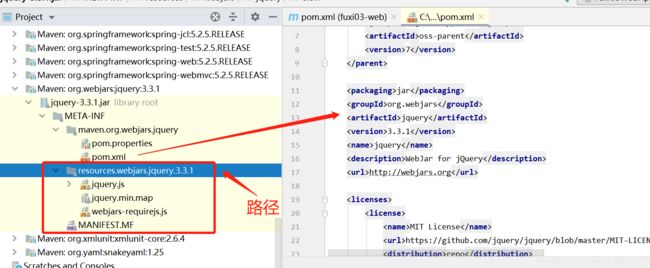
在能看到此路径后,我们可以试着访问里面的资源:
localhost:8080/webjars/jquery/3.3.1/jquery.js
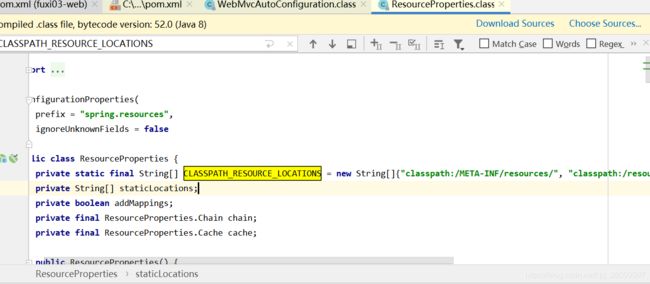
2)、"/**" 访问当前项目的任何资源,都去(静态资源的文件夹)找映射
“classpath:/META-INF/resources/”,
“classpath:/resources/”,
“classpath:/static/”,
“classpath:/public/”
“/”:当前项目的根路径
例:localhost:8080/abc
3)、欢迎页; 静态资源文件夹下的所有index.html页面;被"/**"映射;
例:localhost:8080/ index页面
4)、所有的 **/favicon.ico 都是在静态资源文件下找;
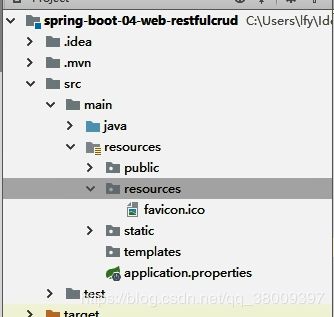
放在里面会自动生效被引用;
注:另外如果在application.yml里面配置了以下,
spring.resources.static.location=XXXX

则原先的默认配置访问路径就会被覆盖失效
二.引入thymeleaf模板引擎
springboot推荐thymeleaf
2.1.引入thymeleaf
<dependency>
<groupId>org.springframework.bootgroupId>
<artifactId>spring-boot-starter-thymeleafartifactId>
dependency>

这边要注意的是:
thymeleaf3版本需要与layout2以上版本才能适配;
thymeleaf2版本与layout1版本才能适配
这个在springboot2.0之前需要在pom.xml的properties里面配置,以覆盖默认版本
springboot2.0版本后无需配置
<properties>
<thymeleaf.version>3.0.9.RELEASEthymeleaf.version>
<thymeleaf-layout-dialect.version>2.2.2thymeleaf-layout-dialect.version>
properties>
2.2.关于thymeleaf
关于thymeleaf的源码也可查看具体的thymeleafAutoConfiguration类,如下:

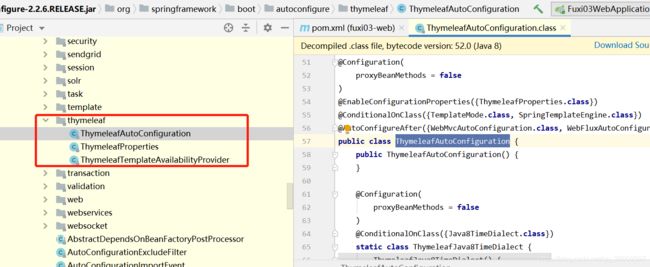
其中比较重要的是对应的ThymeleafProperties:
@ConfigurationProperties(
prefix = "spring.thymeleaf"
)
public class ThymeleafProperties {
private static final Charset DEFAULT_ENCODING;
public static final String DEFAULT_PREFIX = "classpath:/templates/";
public static final String DEFAULT_SUFFIX = ".html";
private boolean checkTemplate = true;
private boolean checkTemplateLocation = true;
private String prefix = "classpath:/templates/";
private String suffix = ".html";
private String mode = "HTML";
简单的例子:
@Controller
public class HelloContoller {
@RequestMapping("/success")
public String goToSuccess(){
//会自动跳到classpath:/templates/success/tml
return "success";
}
}
关于thymeleaf的语法规则,可前往thymeleaf官网下载pdf版本查阅:
3.3.thymeleaf的使用
1.html页面导入thymeleaf的名称空间
<html lang="en" xmlns:th="http://www.thymeleaf.org">
2.使用thymeleaf语法简单使用
<html lang="en" xmlns:th="http://www.thymeleaf.org">
<head>
<meta charset="UTF-8">
<title>Titletitle>
head>
<body>
<h1>成功!h1>
<div th:text="${hello}">这是显示欢迎信息div>
body>
html>
1)th:text;改变当前元素里面的文本内容;
th:任意html属性;来替换原生属性的值
2)、表达式?
Simple expressions:(表达式语法)
Variable Expressions: ${...}:获取变量值;OGNL;
1)、获取对象的属性、调用方法
2)、使用内置的基本对象:
#ctx : the context object. //当前上下文
#vars: the context variables.
#locale : the context locale.
#request : (only in Web Contexts) the HttpServletRequest object.
#response : (only in Web Contexts) the HttpServletResponse object.
#session : (only in Web Contexts) the HttpSession object.
#servletContext : (only in Web Contexts) the ServletContext object.
${session.foo}
3)、内置的一些工具对象:
#execInfo : information about the template being processed.
#messages : methods for obtaining externalized messages inside variables expressions, in the same way as they would be obtained using #{…} syntax.
#uris : methods for escaping parts of URLs/URIs
#conversions : methods for executing the configured conversion service (if any).
#dates : methods for java.util.Date objects: formatting, component extraction, etc.
#calendars : analogous to #dates , but for java.util.Calendar objects.
#numbers : methods for formatting numeric objects.
#strings : methods for String objects: contains, startsWith, prepending/appending, etc.
#objects : methods for objects in general.
#bools : methods for boolean evaluation.
#arrays : methods for arrays.
#lists : methods for lists.
#sets : methods for sets.
#maps : methods for maps.
#aggregates : methods for creating aggregates on arrays or collections.
#ids : methods for dealing with id attributes that might be repeated (for example, as a result of an iteration).
Selection Variable Expressions: *{...}:选择表达式:和${}在功能上是一样;
补充:配合 th:object="${session.user}:
Name: Sebastian.
Surname: Pepper.
Nationality: Saturn.
Message Expressions: #{...}:获取国际化内容
Link URL Expressions: @{...}:定义URL;
@{/order/process(execId=${execId},execType='FAST')}
Fragment Expressions: ~{...}:片段引用表达式
...
Literals(字面量)
Text literals: 'one text' , 'Another one!' ,…
Number literals: 0 , 34 , 3.0 , 12.3 ,…
Boolean literals: true , false
Null literal: null
Literal tokens: one , sometext , main ,…
Text operations:(文本操作)
String concatenation: +
Literal substitutions: |The name is ${name}|
Arithmetic operations:(数学运算)
Binary operators: + , - , * , / , %
Minus sign (unary operator): -
Boolean operations:(布尔运算)
Binary operators: and , or
Boolean negation (unary operator): ! , not
Comparisons and equality:(比较运算)
Comparators: > , < , >= , <= ( gt , lt , ge , le )
Equality operators: == , != ( eq , ne )
Conditional operators:条件运算(三元运算符)
If-then: (if) ? (then)
If-then-else: (if) ? (then) : (else)
Default: (value) ?: (defaultvalue)
Special tokens:
No-Operation: _
3)th:href里面传参
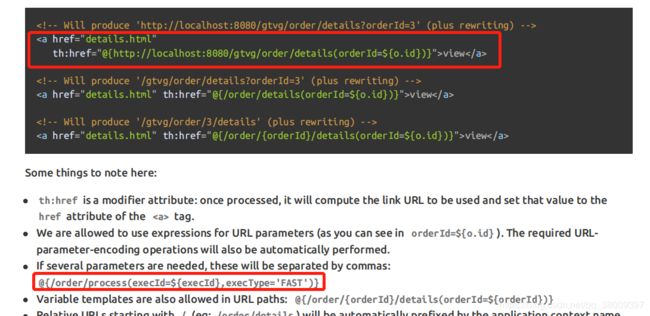
4)foreach使用区别

${user}是后台的值,user是别名,前面text填的就是起的别名;
上面的是三个h4,下面的是h4标签里面3个user
三、springmvc自动配置
以下是SpringBoot对SpringMVC的默认配置:(WebMvcAutoConfiguration)
-
Inclusion of
ContentNegotiatingViewResolverandBeanNameViewResolverbeans. -
Support for serving static resources, including support for WebJars (see below).静态资源文件夹路径,webjars
-
Static
index.htmlsupport. 静态首页访问 -
Custom
Faviconsupport (see below). favicon.ico(浏览器页面上的小图标) -
自动注册了 of
Converter,GenericConverter,Formatterbeans. -
Converter:转换器; public String hello(User user):类型转换使用Converter
-
Formatter格式化器; 2017.12.17===Date;
@Bean
@ConditionalOnProperty(prefix = "spring.mvc", name = "date-format")//在文件中配置日期格式化的规则
public Formatter<Date> dateFormatter() {
return new DateFormatter(this.mvcProperties.getDateFormat());//日期格式化组件
}
自己添加的格式化器转换器,我们只需要放在容器中即可
-
Support for
HttpMessageConverters(see below).-
HttpMessageConverter:SpringMVC用来转换Http请求和响应的;User—Json;
-
HttpMessageConverters是从容器中确定;获取所有的HttpMessageConverter;自己给容器中添加HttpMessageConverter,只需要将自己的组件注册容器中(@Bean,@Component)
-
-
Automatic registration of
MessageCodesResolver(see below).定义错误代码生成规则 -
Automatic use of a
ConfigurableWebBindingInitializerbean (see below).我们可以配置一个ConfigurableWebBindingInitializer来替换默认的;(添加到容器)
ConfigurableWebBindingInitializer的作用: 初始化WebDataBinder; 请求数据绑定=====JavaBean;
jar包org.springframework.boot.autoconfigure.web路径下:可查看XXXAutoConfiguration关于web的所有自动场景;
下面有一段官方说明:
If you want to keep Spring Boot MVC features, and you just want to add additional MVC configuration (interceptors, formatters, view controllers etc.) you can add your own @Configuration class of type WebMvcConfigurerAdapter, but without @EnableWebMvc. If you wish to provide custom instances of RequestMappingHandlerMapping, RequestMappingHandlerAdapter or ExceptionHandlerExceptionResolver you can declare a WebMvcRegistrationsAdapter instance providing such components.
If you want to take complete control of Spring MVC, you can add your own @Configuration annotated with @EnableWebMvc.
这段话什么意思呢?
意思是:
1、如果你想保留springboot mvc的特性,而你想添加一些额外的特性(比如转换器、拦截器等),我们可以自定义一些配置类用
@Configuration标注,是WebMvcConfigurerAdapter类型,但是不要用@EnableWebMvc;这样的话既保留了所有的自动配置,也能用我们扩展的配置;
2、如果你想完全接管mvc,则要用@EnableWebMvc。
3.1.WebMvcAutoConfiguration中ContentNegotiatingViewResolver讲解
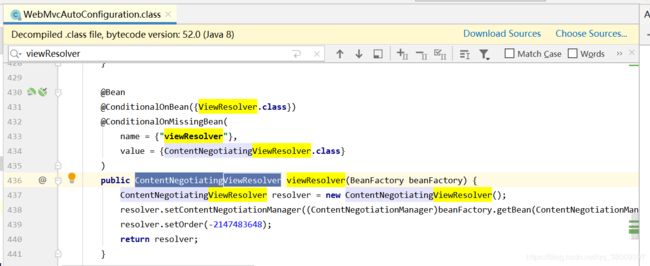
我们再进入ContentNegotiatingViewResolver看看(ContentNegotiatingViewResolver:组合所有的视图解析器的;)
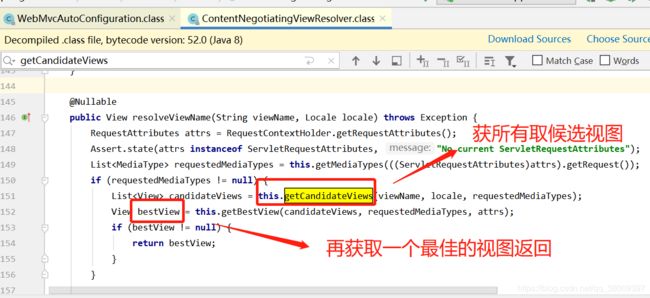
3.2.修改SpringBoot的默认配置
模式:
1)、SpringBoot在自动配置很多组件的时候,先看容器中有没有用户自己配置的(@Bean、@Component)如果有就用用户配置的,如果没有,才自动配置;如果有些组件可以有多个(ViewResolver)将用户配置的和自己默认的组合起来;
2)、在SpringBoot中会有非常多的xxxConfigurer帮助我们进行扩展配置
3)、在SpringBoot中会有很多的xxxCustomizer帮助我们进行定制配置
3.2.1拓展springmvc
例子:使用WebMvcConfigurerAdapter可以来扩展SpringMVC的功能
既保留了所有的自动配置,也能用我们扩展的配置;
//使用WebMvcConfigurerAdapter可以来扩展SpringMVC的功能
@Configuration
public class MyMvcConfig extends WebMvcConfigurerAdapter {
@Override
public void addViewControllers(ViewControllerRegistry registry) {
// super.addViewControllers(registry);
//浏览器发送 /atguigu 请求来到 success
registry.addViewController("/atguigu").setViewName("success");
}
}
原理:
1)、WebMvcAutoConfiguration是SpringMVC的自动配置类
2)、在做其他自动配置时会导入;@Import({WebMvcAutoConfiguration.EnableWebMvcConfiguration.class})
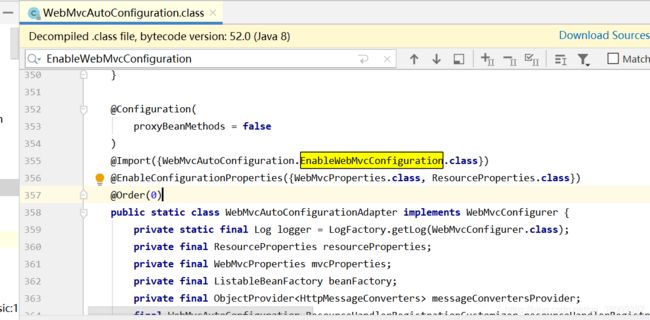
boot1.5中是这样的,意思就是:
从容器中获取所有的WebMvcConfigurer,将所有的WebMvcConfigurer相关配置都来一起调用(默认的加拓展的)
@Configuration
public static class EnableWebMvcConfiguration extends DelegatingWebMvcConfiguration {
private final WebMvcConfigurerComposite configurers = new WebMvcConfigurerComposite();
//从容器中获取所有的WebMvcConfigurer
@Autowired(required = false)
public void setConfigurers(List<WebMvcConfigurer> configurers) {
if (!CollectionUtils.isEmpty(configurers)) {
this.configurers.addWebMvcConfigurers(configurers);
//一个参考实现;将所有的WebMvcConfigurer相关配置都来一起调用;
@Override
// public void addViewControllers(ViewControllerRegistry registry) {
// for (WebMvcConfigurer delegate : this.delegates) {
// delegate.addViewControllers(registry);
// }
}
}
}
3)、容器中所有的WebMvcConfigurer都会一起起作用;
4)、我们的配置类也会被调用;
效果:SpringMVC的自动配置和我们的扩展配置都会起作用;
3.2.1全面接管springmvc
SpringBoot对SpringMVC的自动配置不需要了,所有都是我们自己配置;所有的SpringMVC的自动配置都失效了
我们需要在配置类中添加@EnableWebMvc即可;
//使用WebMvcConfigurerAdapter可以来扩展SpringMVC的功能
@EnableWebMvc
@Configuration
public class MyMvcConfig extends WebMvcConfigurerAdapter {
@Override
public void addViewControllers(ViewControllerRegistry registry) {
// super.addViewControllers(registry);
//浏览器发送 /atguigu 请求来到 success
registry.addViewController("/atguigu").setViewName("success");
}
}
原理:
为什么@EnableWebMvc自动配置就失效了;
1)@EnableWebMvc的核心 导入了DelegatingWebMvcConfiguration
@Import(DelegatingWebMvcConfiguration.class)
public @interface EnableWebMvc {
2)DelegatingWebMvcConfiguration 又继承了WebMvcConfigurationSupport
@Configuration
public class DelegatingWebMvcConfiguration extends WebMvcConfigurationSupport {
3)而这边@ConditionalOnMissingBean(WebMvcConfigurationSupport.class) 没有这个WebMvcConfigurationSupport类才生效,因为@EnableWebMvc导入了,所以默认配置不生效了
@Configuration
@ConditionalOnWebApplication
@ConditionalOnClass({ Servlet.class, DispatcherServlet.class,
WebMvcConfigurerAdapter.class })
//容器中没有这个组件的时候,这个自动配置类才生效
@ConditionalOnMissingBean(WebMvcConfigurationSupport.class)
@AutoConfigureOrder(Ordered.HIGHEST_PRECEDENCE + 10)
@AutoConfigureAfter({ DispatcherServletAutoConfiguration.class,
ValidationAutoConfiguration.class })
public class WebMvcAutoConfiguration {
4)、@EnableWebMvc将WebMvcConfigurationSupport组件导入进来;
5)、导入的WebMvcConfigurationSupport只是SpringMVC最基本的功能;
